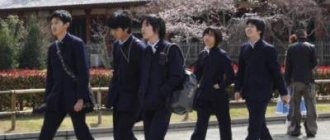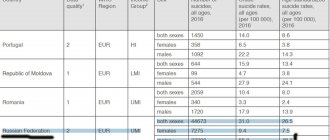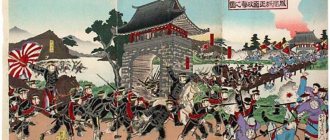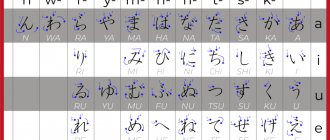annotation
Our website “Fushigi Nippon - Mysterious Japan” is dedicated to the culture of Japan, Japanese art and traditions, as well as the life of ordinary Japanese. Every day we have new information about this wonderful country - articles dedicated to Japan, reviews of anime and works of famous Japanese painters, as well as recipes for Japanese cuisine and much more.
The main section of the site is articles about Japan , which covers all aspects of Japanese culture: from society and native Japanese customs to the secrets and history of Japanese cuisine and art.
More information about the “ Articles about Japan ” section:
The Geography section provides a map of Japan, describes the geographical location of the country and its administrative-territorial division.
The articles in the State are devoted to Japanese society and the problems it struggles with. the Gaijin Directory will be of undoubted interest , which lists the most necessary things: how much housing costs in Japan, how to send a child to kindergarten, how to get health insurance in Japan and much more. It will be useful to familiarize yourself with the Japanese Constitution.
The Art of Japan section contains articles on many different areas: there are articles devoted to Japanese theater and handicrafts, ikebana and bonsai, and also provides advice on the practice of Feng Shui and arranging a Japanese garden on your site. The section also contains articles dedicated to outstanding Japanese figures - directors, painters, voice actors - i.e. those who made a tangible contribution to the development of Japanese culture.
Articles in the History will tell about the hard everyday life of samurai, their training and schools, the arrangement of medieval Japanese society, the Meiji Restoration and other stages of Japanese history. The history of Japan is rich in a variety of events, which, for convenience, are presented in a separate article and presented in chronological order. The reigns of the first Japanese kings and shoguns are given.
In the Cooking you will find descriptions of such popular Japanese cuisine products as tofu, soy sauce, tuna, wasabi, daikon and others; learn how to prepare sake at home, how to eat with chopsticks and set the table in Japanese style.
The culture of Japan is very unique and often incomprehensible to residents of other countries. the Culture section are intended to eliminate barriers of misunderstanding , which will talk about relations in Japan between men and women, about the Japanese sense of beauty and beauty, about personal and public communication between Japanese, and also tell about the position of women in modern Japanese society, accepted norms of business etiquette in communicating with the Japanese and many other aspects characteristic of the residents of this particular country.
In the Literature you can get acquainted with very unique Japanese poetry (for example, haiku (hoku) and tanka), Japanese myths and legends, as well as Japanese fairy tales, sometimes sad, and sometimes completely incomprehensible to Westerners. The section also presents collections of samurai ethics: “Hagakure”, written by Yamamoto Tsunetomo, and “The Book of Five Rings”, written by the sword master Miyamoto Musashi.
The Japanese are not devout, but they are religious, and their indigenous religion, Shinto, is a unique amalgamation of animistic beliefs dating back centuries. Buddhism is also widespread in Japan, but has changed under the pressure of circumstances over time. You can read more about Shintoism and Buddhism in the Religion .
Japanese traditions and the behests of their ancestors are unshakable and are sacredly observed after many centuries: tea and wedding ceremonies are still held, and modern Japanese businessmen still honor the Code of Bushido and follow the instructions taught to young samurai. Traditions section also covers holidays celebrated in Japan.
The Japanese language is very unique and, like Chinese, is based on hieroglyphs. Japanese characters represent entire syllables, and often words at once, and can be written in several ways. The simplest way is the katakana alphabet, which is currently used for the most part to write foreign words and borrowings. More complex than katakana is hiragana, which is used to write ordinary Japanese words and is characterized by smoother lines. The language of the people is most clearly manifested in proverbs and sayings, which are presented in large numbers in the Language . Also, do not forget about non-verbal means of communication (facial expressions and gestures), which are also given attention in the articles.
There is also an Encyclopedia in which you can learn a lot of new things. For example, the encyclopedia “Male and Female Japanese Names” contains about 2000 names, and the encyclopedia “Japanese Words and Expressions” can find the meanings of many different Japanese expressions. The Japanese Gods Encyclopedia contains information about the most significant and famous gods of the Japanese pantheon, and the Japanese Cuisine Encyclopedia will provide explanations regarding the terminology of Japanese cuisine.
Japanese Cuisine section contains a large number of recipes for Japanese cuisine, for example, sushi and sashimi recipes, Japanese soup recipes, Japanese sweets recipes and many others. Most of the recipes are very simple to follow, and in terms of exoticism, Japanese cuisine is perhaps rivaled only by Chinese cuisine. The main ingredients for the dishes are a variety of seafood (tuna, shrimp, eel and, of course, fugu) and seaweed (kombu, for example), as well as, of course, rice and vegetables (daikon, beans, celery and others). Soy products are also popular - tofu and miso, and the king of products from this plant is soy sauce! Recently, the Japanese have begun to actively consume products typical of Western cuisine, but traditional culinary recipes are still loved and not forgotten, which is not surprising, because in addition to its exoticism, Japanese cuisine is the healthiest in the world, and the Japanese diet helps the indigenous people The Land of the Rising Sun will live to a very old age in good spirits and sound mind. Helpful Tips section is intended to help cooks , where you can find information on how to replace some ingredients that are unique to Japanese cuisine.
Anime Reviews section is dedicated to evaluating and discussing one of the areas of modern Japanese culture - anime. Anyone can send their review of the anime, as well as leave comments.
Origami diagrams and kusudama diagrams contain descriptions and instructions for assembling many models of origami and modular origami - a Japanese art that has gained incredible popularity throughout the world. The presented patterns have different levels of complexity and even a novice origamist can find a pattern to suit his taste and skill.
Japanese prints are very original and often very skillfully made, so the works of famous Japanese artists such as Katsushika Hokusai, Ando Hiroshige and other painters the Photo Gallery Also in the Photo Gallery you can find the creativity of our readers and photographs of modern Japan.
For communication and discussion of materials, we have a convenient Forum , the main sections of which are “Anime and Manga”, “All about Japan”, “Our Creativity”, “Culinary Duel” and “Tea House”. A variety of topics are discussed: Japanese cinema, features of Japanese cuisine, Japanese painting, anime and much more.
Leaders[edit]
| No. | Photo | Name | Term of office | ||
| Took office | Left office | ||||
| Chairman of the Social Democratic Party of Japan | |||||
| 1 | Tetsu Katayama | September 28, 1946 | January 16, 1950 | ||
| Chairman of the Social Democratic Party of Japan (Right) | |||||
| — | Jotaro Kawakami | January 19, 1951 | October 12, 1955 | ||
| Chairman of the Japanese Socialist Party (Left) | |||||
| — | Suzuki Mosaburo | January 18, 1951 | October 12, 1955 | ||
| Chairman of the Social Democratic Party of Japan (Unified) | |||||
| 2 | Suzuki Mosaburo | October 12, 1955 | March 23, 1960 | ||
| 3 | Inejiro Asanuma | March 23, 1960 | October 12, 1960 (killed) | ||
| — | Saburo Eda (acting) | October 12, 1960 | March 6, 1961 | ||
| 4 | Jotaro Kawakami | March 6, 1961 | May 6, 1965 | ||
| 5 | Kozu Sasaki | May 6, 1965 | August 19, 1965 | ||
| 6 | Seiichi Katsumata | August 19, 1965 | October 4, 1968 | ||
| 7 | Tomomi Narita | November 30, 1968 | September 26, 1977 | ||
| 8 | Ichio Asukata | December 13, 1977 | September 7, 1983 | ||
| 9 | Masashi Ishibashi | September 7, 1983 | September 8, 1986 | ||
| 10 | Takako Doi | September 9, 1986 | July 31, 1991 | ||
| 11 | Makoto Tanabe | July 31, 1991 | January 19, 1993 | ||
| 12 | Sadao Yamahahana | January 19, 1993 | September 25, 1993 | ||
| 13 | Tomiichi Murayama | September 25, 1993 | January 19, 1996 | ||
Links[edit]
- ^ B s d e g h
ブリタニカ国際大百科事典小項目事典の解説 [
Encyclopædia Britannica:
Micropædia
explained ].
kotobank.jp
(in Japanese). Asahi Shimbun Company. Retrieved November 22, 2020. - ^ a b c d e f
Taguchi, Fukuji.
日本大百科全書 (ニッポニカ)の解説 [ Nihon Dai Hyakka Zensho:
Nipponics
Explained ].
kotobank.jp
(in Japanese). Asahi Shimbun Company. Retrieved November 19, 2020. - [What is Sakai Shimpo? § Encyclopædia Britannica:
Micropædia
explained ].
kotobank.jp
(in Japanese). Asahi Shimbun Company. Retrieved November 22, 2020. - “Social Democratic Party of Japan | political party, Japan". Encyclopedia Britannica Online
. Big Encyclopedic Dictionary Inc. Retrieved November 22, 2020. - Docherty, James S.; Lamb, Peter (2006). Historical Dictionary of Socialism
. Series “Historical Dictionaries of Religions, Philosophies and Movements” (2nd ed.). Scarecrow Press. item 186. ISBN. 978-0-8108-5560-1. Retrieved November 22, 2021. - 2019
) . 麥浩斯. paragraph 50. ISBN 978-986-408-463-0. - Lee, Yun Wook. "The Origins of One-Party Domination: America's Reversal and the Emergence of the Liberal Democratic Party in Japan". Journal of East Asian Affairs
. Vol. 18 (No. 2): 388. Retrieved January 26, 2021. - Hoover, William D. (2011). Historical Dictionary of Post-War Japan
. Plymouth, UK: Scarecrow Press. paragraph 33. ISBN 978 0 8108 5460 4. - Takemae, Eiji (January 2003). Allied occupation of Japan
. ISBN 9780826415219. Archived from the original on May 3, 2021. Retrieved July 12, 2015. - "Occupation and Reconstruction of Japan, 1945–52". Retrieved January 26, 2021. By late 1947 and early 1948, the emergence of an economic crisis in Japan, along with fears about the spread of communism, prompted a review of occupation policy. This period is sometimes called the "reverse course".
- Schonberger, Howard B. (1989). After the War: Americans and the Remaking of Japan, 1945–1952
. Kent, OH: Kent State University Press. paragraphs 64-72. ISBN 0 87338 382 6. - Dower, John W.; Hirata, Tetsuo. "Japan's Red Purge: Lessons from the Saga of the Suppression of Free Speech and Thought". Asia Pacific Journal
.
5
(7): 3. Retrieved January 26, 2021. - Socialist Parties in Postwar Japan, Allan B. Cole, George O. Totten [and] Cecil H. Uehara, New Haven: Yale University Press, 1966.
- James S. Docherty; Peter Lamb (2 October 2006). Historical Dictionary of Socialism
. Scarecrow Press. P. 186–. ISBN 978-0-8108-6477-1. Retrieved January 29, 2013. - Kapoor, Nick (2018). Japan at a Crossroads: Conflict and Compromise after Anpo
. Cambridge, MA: Harvard University Press. pp. 109–113. ISBN 978-0-6749-8442-4. - Kapoor, Nick (2018). Japan at a Crossroads: Conflict and Compromise after Anpo
. Cambridge, MA: Harvard University Press. paragraph 127. ISBN 978-0-6749-8442-4. - Kapoor, Nick (2018). Japan at a Crossroads: Conflict and Compromise after Anpo
. Cambridge, MA: Harvard University Press. pp. 125–26. ISBN 978-0-6749-8442-4. - Modern Japan by Duncan McCargo
- "Towards Political Inclusion: The Changing Role of Local Government in Japan" (PDF). Archived (PDF) from the original on 2012-12-02. Retrieved April 20, 2012.
- Hein, Carola; Pelletier, Philippe (27 September 2006). Cities, Autonomy and Decentralization in Japan
. ISBN 9781134341504. Archived from the original on November 27, 2021. Retrieved July 12, 2015. - Stockwin, J. A. A. (2003-12-16). Dictionary of Contemporary Japanese Politics
. Taylor and Francis. paragraph 239. ISBN 9780203402177. Retrieved July 12, 2015. Japan Tokyo Governor Minobe free medical care. - Muramatsu, Michio; Iqbal, Farrukh; Kume, Ikuo (2001). The Development of Local Government in Postwar Japan
. ISBN 9780199248285. Archived from the original on November 27, 2021. Retrieved July 12, 2015. - Gaunder, Alice (2011-02-25). The Routledge Handbook of Japanese Politics
. ISBN 9781136818387. Archived from the original on November 27, 2021. Retrieved July 12, 2015. - "FEATURE: Seeds Planted by 'Progressive' Governments Still Growing in Japan". Retrieved July 12, 2015.
- "Controlled Decentralization: Local Governments and Japan's Ministry of the Interior" (PDF). Archived (PDF) from the original on 2015-07-12. Retrieved August 10, 2013.
- Tsuzuki, Chushichi (2000-04-13). The quest for power in modern Japan 1825–1995
. ISBN 9780191542459. Archived from the original on May 3, 2021. Retrieved July 12, 2015. - Kotobank
. _ Archived from the original on 2020-02-26. Retrieved February 26, 2020. - Kotobank
. _ Archived from the original on 2020-02-26. Retrieved February 26, 2020. - Ian Neri (October 12, 2012). War, Revolution and Japan
. Taylor and Francis. P. 141–. ISBN 978-1-873410-08-0. Retrieved January 29, 2013. - 高山直人 (2019).左翼大辞典
. 明哲の舎. item 7. GGKEY: 9NSLG3F0CUC.
Election results[edit]
General election results[edit]
| Elections | Leader | Number of places won | Number of votes in the district | % of district votes | Number of PR block votes | % of PR block votes | Government | |
| Japanese Socialist Party era | ||||||||
| 1946 | Tetsu Katayama | 96/466 | 10 069 907 | 18,2 | Opposition | |||
| 1947 | Tetsu Katayama | 144/466 | 7 203 050 | 26,3 | Coalition | |||
| 1949 | Tetsu Katayama | 48/466 | 4,129,794 | 13,8 | Opposition | |||
| 1952 | Jotaro Kawakami Mosaburo Suzuki | 116/466 | 8 001 745 | 22,6 | Opposition | |||
| 1953 | Jotaro Kawakami Mosaburo Suzuki | 138/466 | 9 194 548 | 26,6 | Opposition | |||
| 1955 | Jotaro Kawakami Mosaburo Suzuki | 156/466 | 10 812 906 | 29,2 | Opposition | |||
| 1958 | Mosaburo Suzuki | 167/467 | 13 155 715 | 33,1 | Opposition | |||
| 1960 | Jotaro Kawakami | 144/467 | 10 839 130 | 27,4 | Opposition | |||
| 1963 | Jotaro Kawakami | 144/467 | 11 906 766 | 29,0 | Opposition | |||
| 1967 | Kozo Sasaki | 140/486 | 12 826 104 | 27,9 | Opposition | |||
| 1969 | Tomomi Narita | 90/486 | 10 074 101 | 21,4 | Opposition | |||
| 1972 | Tomomi Narita | 118/491 | 11 478 142 | 21,9 | Opposition | |||
| 1976 | Tomomi Narita | 123/511 | 11 713 009 | 20,7 | Opposition | |||
| 1979 | Ichio Asukata | 107/511 | 10 643 450 | 19,7 | Opposition | |||
| 1980 | Ichio Asukata | 107/511 | 11 400 747 | 19,3 | Opposition | |||
| 1983 | Masashi Ishibashi | 112/511 | 11 065 082 | 19,5 | Opposition | |||
| 1986 | Masashi Ishibashi | 85/512 | 10 412 584 | 17,2 | Opposition | |||
| 1990 | Takako Doi | 136/512 | 16 025 473 | 24,4 | Opposition | |||
| 1993 | Sadao Yamahahana | 70/511 | 9 687 588 | 15.4 | Eight-party coalition (1993–1994) | |||
| LDP–JSP–NPS coalition (1994–1996) | ||||||||
Councilor election results[edit]
| Elections | Leader | Total number of seats | Number of places won | Number of national votes | % of national votes | Number of prefectural votes | % of prefectural votes | |
| Japanese Socialist Party era | ||||||||
| 1947 | Tetsu Katayama | 47/250 | 3 479 814 | 16,4% | 4 901 341 | 23,0% | ||
| 1950 | Tetsu Katayama | 61/250 | 36/125 | 4 854 629 | 17,3% | 7 316 808 | 25,2% | |
| 1953 | Mosaburo Suzuki | 66/250 | 28/125 | 5,559,875 | 20,7% | 6 870 640 | 24,5% | |
| 1956 | Mosaburo Suzuki | 80/250 | 49/127 | 8 549 940 | 29,9% | 11 156 060 | 37,6% | |
| 1959 | Mosaburo Suzuki | 85/250 | 38/127 | 7 794 754 | 26,5% | 10 265 394 | 34,1% | |
| 1962 | Jotaro Kawakami | 66/250 | 37/127 | 8 666 910 | 24,2% | 11 917 675 | 32,8% | |
| 1965 | Kozo Sasaki | 73/251 | 36/127 | 8 729 655 | 23,4% | 12 346 650 | 32,8% | |
| 1968 | Tomomi Narita | 65/250 | 28/126 | 8 542 199 | 19,8% | 12 617 680 | 29,2% | |
| 1971 | Tomomi Narita | 66/249 | 39/125 | 8 494 264 | 21,3% | 12 597 644 | 31,2% | |
| 1974 | Tomomi Narita | 62/250 | 28/130 | 7 990 457 | 15,2% | 13 907 865 | 26,0% | |
| 1977 | Ichio Asukata | 56/249 | 27/126 | 8 805 617 | 17,3% | 13 403 216 | ||
| 1980 | Ichio Asukata | 47/250 | 22/126 | 7 341 828 | 13,1% | 12 715 880 | ||
| 1983 | Ichio Asukata | 44/252 | 22/126 | 7 590 331 | 16,3% | 11 217 515 | ||
| 1986 | Takako Doi | 41/252 | 20/126 | 9 869 088 | 12 464 579 | |||
| 1989 | Takako Doi | 68/252 | 45/126 | 19 688 252 | 35,1% | 15 009 451 | 26,4% | |
| 1992 | Takako Doi | 71/252 | 22/126 | 7 981 726 | 17,8% | 7 147 140 | 15,8% | |
| 1995 | Tomiichi Murayama | 37/252 | 16/126 | 6 882 919 | 16,9% | 4 926 003 | 11,9% | |









